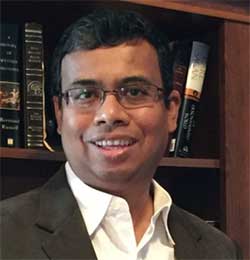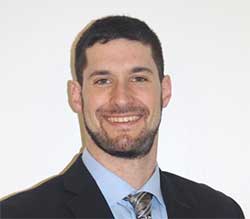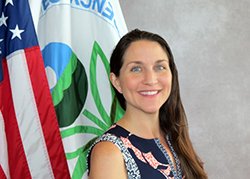An Overview of the Fundamentals of Sequence Stratigraphy and its Application to Developing Robust Conceptual Site Models and Remedial Strategies
Sponsored by: Society of American Military Engineers (SAME) Denver Post, SAME Philadelphia Post, and US EPA
Archived: Wednesday, January 15, 2020
An Overview of the Fundamentals of Sequence Stratigraphy and its Application to Developing Robust Conceptual Site Models and Remedial Strategies
2020-01-15
Society of American Military Engineers (SAME) Denver Post, SAME Philadelphia Post, and US EPA
The Society of American Military Engineers (SAME) Denver Post and Philadelphia Post along with the US Environmental Protection Agency (EPA) are hosting a series of webinars based on talks given at recent Design and Construction Issues at Hazardous Waste Sites (DCHWS) Symposiums. The mission of the DCHWS symposiums is to facilitate an interactive engagement between professionals from government and the private sector related to relevant and topical issues affecting applications of engineering and science associated with cleaning up hazardous waste sites. The symposiums also serve as a platform to facilitate the exchange of information, encourage dialogue, share experiences, and build and enhance communication among design and construction professionals.
Sequence stratigraphy has arguably revolutionized stratigraphic analysis in the oil and gas industry since the 1970s, but to date, few environmental companies have utilized this power tool. Although many companies have intended on using sequence stratigraphic correlation techniques to define the subsurface heterogeneity, they have mistakenly used lithostratigraphy, significantly limiting their ability to construct accurate CSMs and develop effective remedial strategies. In this seminar, we will leverage case studies to make participants aware of the pitfalls of lithostratigraphy and highlight the role of sequence stratigraphy in generating robust and realistic hydrogeological models.
Upcoming Design and Construction Issues at Hazardous Waste Sites (DCHWS) Series Webinars
Design and Construction Issues at Hazardous Waste Sites (DCHWS) Series Archives
- Ten Years of Optimization of the Environmental Restoration program at a DoD Facility in North Carolina (Sep 15, 2021)
- Risk Management During the Cost Estimating Process (Jul 14, 2021)
- Increasing Treatment Certainty while Controlling Remediation Cost - Case Studies using Hydraulic Fracturing to Deliver Amendments at Low-Permeability Sites (Jul 14, 2021)
- Design and Construction Issues at Hazardous Waste Sites Webinar on Successful Remedial Design, Session 2 (May 12, 2021)
- Design and Construction Issues at Hazardous Waste Sites Webinar on Successful Remedial Design, Session 1 (May 12, 2021)
- An Environmental Cold Case Detective Story: Discovery and Repair of the Soil Cover on the Cell 3 Landfill (Apr 28, 2021)
- 2021 Design and Construction at Hazardous Waste Sites Virtual Symposium (Apr 1, 2021)
- 2021 Design and Construction at Hazardous Waste Sites Virtual Symposium (Mar 31, 2021)
- 2021 Design and Construction at Hazardous Waste Sites Virtual Symposium (Mar 29, 2021)
- EPA Region 2 Forty Years to the Finish - A Case Study of Combe Fill South Landfill Superfund Site (Jan 13, 2021)
- 2020 Design and Construction at Hazardous Waste Sites Virtual Symposium: Panel 5 and Panel 6 (Oct 28, 2020)
- 2020 Design and Construction at Hazardous Waste Sites Virtual Symposium: Panel 3 and Panel 4 (Oct 27, 2020)
- 2020 Design and Construction at Hazardous Waste Sites Virtual Symposium: Panel 1 and Panel 2 (Oct 26, 2020)
- Former BICC Cables Site Construction Hudson River Sediment Cap Under the EPRI Building Yonkers, Westchester County, New York (Jun 10, 2020)
- Integration of Resiliency and Sustainability into Remedy Evaluation, Design, and O&M: A Compilation of Case Study Findings (May 13, 2020)
- Heat Enhanced Hydrolysis of Energetic Compounds and Field Results (Apr 8, 2020)
- Reducing Cost Risk in Remedial Action Budgets Using Supplemental Analyses (Mar 11, 2020)
- Investigation, Design, Construction, and Optimization of a Large-Scale Combined In Situ Thermal Treatment and Enhanced Bioremediation Remedy (Feb 12, 2020)
- An Overview of the Fundamentals of Sequence Stratigraphy and its Application to Developing Robust Conceptual Site Models and Remedial Strategies (Jan 15, 2020)
- Construction Manager Perspective: Lessons Learned Implementing the Superfund Job Training Initiative (Super JTI) (Dec 11, 2019)
- Substrate Longevity and Long-Term Performance of Biochemical Reactors for Passive Treatment of Mine-Impacted Water (Nov 25, 2019)
- Harnessing Natural River Processes to Remediate 120 km of the Big River in Jefferson County, Missouri (Sep 25, 2019)
Accessibility, Recording, and Content Disclaimer
Rehabilitation Act Notice for Reasonable Accommodation
It is EPA's policy to make reasonable accommodation to persons with disabilities wishing to participate in the agency's programs and activities, pursuant to the Rehabilitation Act of 1973, 29 U.S.C. 791. Any request for accommodation should be made to Kate Garufi at 703-517-5857 or garufi.katherine@epa.gov, preferably one week or more in advance of the webinar, so that EPA will have sufficient time to process the request. EPA would welcome specific recommendations from requestors specifying the nature or type of accommodation needed. Please note that CLU-IN provides both alternate phone call-in options and closed captioning for all webinars, and requests for these specific accommodations are not necessary.
Webinar Recording
By participating in this CLU-IN webinar, you automatically agree to authorize recording of audio and visual content presented during this live event and consent to subsequent use of this recording in the public domain by the U.S. Environmental Protection Agency. This recording may include questions, comments and poll responses provided by you during the live event in addition to your name, voice, image or likeness. This recording will be made available after the conclusion of the live event as part of the CLU-IN webinar archives, and will remain available indefinitely. If you do not wish to consent to the recording, please do not join the live event, and contact Jean Balent at 202-566-0832 or balent.jean@epa.gov to discuss your concerns.
Content Disclaimer
This webinar is intended solely to provide information to the public. The views and opinions expressed as part of this webinar do not necessarily state or reflect those of the U.S. Environmental Protection Agency. It is not intended, nor can it be relied upon, to create any rights enforceable by any party in litigation with the United States, or to endorse the use of products or services provided by specific vendors. With respect to this webinar, neither the United States Government nor any of their employees, makes any warranty, express or implied, including the warranties of merchantability and fitness for a particular purpose, or assumes any legal liability or responsibility for the accuracy, completeness, or usefulness of any information, apparatus, product, or process disclosed, or represents that its use would not infringe privately owned rights.
Presenters:
 Junaid Sadeque, AECOM (Junaid.Sadeque@aecom.com)
Junaid Sadeque, AECOM (Junaid.Sadeque@aecom.com)
Dr. Junaid Sadeque is a recognized Subject Matter Expert in sequence stratigraphy and sedimentology. As a Senior Geologist at AECOM, he plays a pivotal role in applying sequence stratigraphic concepts for predicting contamination flow paths and developing CSMs. Over the past 10 years, he has taught numerous professional courses in applied sequence stratigraphy both locally and internationally. His strong background of previously working for the oil sector helps him bring in fresh and cutting-edge concepts of geology to the environmental world. He has a Master's in Petroleum Geology from the University of Bergen, Norway, and a PhD. From UT Dallas, Texas.
 Ryan Samuels, AECOM (Ryan.Samuels@aecom.com)
Ryan Samuels, AECOM (Ryan.Samuels@aecom.com)
Ryan Samuels holds a MS degree, Sequence Stratigraphy from Texas A&M University- College Station, and a BA degree, Geology from Franklin and Marshall College. His education and career have focused on extrapolating sedimentological and stratigraphic information from cores and well-logs for sequence stratigraphic analysis. Prior to joining AECOM he was in the petroleum industry, conducting sequence stratigraphic analysis in the Denver Basin, Powder River Basin, and Gulf of Mexico. But now, as a lead stratigrapher at AECOM, he is successfully applying his technical skills to develop comprehensive, integrated Conceptual Site Models and guide the design of cost-effective remedial strategies.
Moderator:
 Jean Balent, U.S. EPA Technology Innovation and Field Services Division (balent.jean@epa.gov or 202-566-0832)
Jean Balent, U.S. EPA Technology Innovation and Field Services Division (balent.jean@epa.gov or 202-566-0832)
Ms Balent is on the staff of the EPA's Technology Innovation and Field Services Division where she has worked to collect and disseminate hazardous waste remediation and characterization information since 2003. Ms Balent manages the Clean Up Information Network website and actively supports online communication and collaboration resources available to EPA. She formerly worked with the US Army Corps of Engineers Environmental Engineering Division in the Buffalo District. Ms Balent was also a member of the SUNY-Buffalo Groundwater Research Group where she constructed and tested large scale models of groundwater flow. Ms Balent has also conducted research relating to the Great Lakes, environmental remediation, and brownfields re-development. She holds a Bachelor's degree in environmental engineering from SUNY-Buffalo and a Master's degree in Information Technology from AIU.
Webinar Slides and References:
Webinar Slides and References:
Additional Resources:
- These materials will be available by Wednesday, January 15, 2020
If you have a suggested topic or idea for a future CLU-IN internet seminar, please contact:
Technology Integration and Information Branch
PH: 202-566-0832 | Email: balent.jean@epa.gov
Technology Integration and Information Branch
PH: 202-566-0875 | Email: adam.michael@epa.gov





